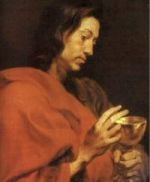Catholic Activity: Party for the Feast of Our Lady of Guadalupe
Ideas adapted from Mexico for your own celebration for Our Lady of Guadalupe.
DIRECTIONS
In Oaxaca, Mexico, on the eve of the feast of the Virgen of Guadalupe, babies and toddlers are dressed in representation of the many Indian tribes of Mexico. The procession begins at El Catedral on the zócalo and fills the streets, accompanied by singing and punctuated by firecrackers. It ends at her church on the Llano Park, for the mass of thanksgiving for her protection and grace.
On the following day, the children are brought again. In the hot Mexican sun, blue-black hair gleams, deep facial shadows contrast with brilliant highlights on the copper skin of children. Colored ribbons in the babies' hair and strands of glass beads glisten and shine. The children are patient, as they wait in the long line to pass through the church, to leave their baskets of roses or poinsettias, to light the candles and to pray. They sometimes fuss when their parents rearrange the tilmas or re-paint their smudged moustaches. But they seem to understand that this is an important affair, and quietly wait their turn to revere the Holy Mother.
Costumes of all kinds reflect the variety of Mexican traditions. As in other human clothing, the females have more choices in finery. The boys are usually dressed in white muslin, red belts and huaraches. The brims of their woven palm hats are turned up in the front, framing a paper image of the Virgin. This arrangement gives them an endearing, slightly comical look. The moustache drawn on with eyebrow pencil transforms the round-faced baby into Juan Diego. On the tilma the image of Guadalupe appears as she did on the cloth of Juan Diego, centuries ago. Some of the youngsters carry a costalito, equipped with a forehead strap and decorated with miniature articles like a petate and kitchen instruments, necessary for a long pilgrimage. They will bring offerings of flowers, the poinsettia of the season, or roses like the ones Guadalupe sent to the bishop, as proof of her apparition.
While most boys are in white, you will meet the occasional charro (Mexican cowboy) with his huge hat, flashy bandana, and silver coins down the sides of his pant-legs. But the little girls steal the show. From the tiniest baby to the most demure teenager, each one is delightful. The traditional costume is a puff-sleeved embroidered blouse, multicoloured rebozo and a gathered flowered skirt. They wear strands of brightly coloured beads and long braids (often made from dark yarn, ingeniously attached to their shorter hair) and carry baskets of flowers. But especially in Oaxaca, with its 16 official ethnic groups, the costumes are varied. You can see little Tehuanas, Yalaltecas, Mazatecas, a rebozo gracefully wrapping the head, huipiles both sumptuous and austere.
Of course, it's not all serious. The Llano Park is taken over by secular pleasures as well -- mechanical rides, marble-rolling for prizes, and balloons that manage to dodge the menacing darts, for that elusive plaster eagle or authentic image of Pokeman. Oh, and the food! Children delight in the flavoured ices, popsicles, cups of gelatines and cotton candy; and the smells of little fried gorditas Guadalupanas, and all the other antojitos of Oaxacan cuisine fill the air.
And then, the commemorative photograph. Not as common in years past, nowadays the ingenuity for photo-ops is delightful. They will pose the children on the traditional burro, dressed up with crepe paper and flowers with the image of the virgin up on top. If sitting on a burro is too distressing for the little one, there are peaceful grottoes, with the figure of Juan Diego kneeling before the Blessed Mother, that can serve as a background. The mujercitas demonstrate crushing corn on a metate (look up at the camera and smile, mi hija), or cooking the tortillas on the comal. (first let's straighten up the bows, and braids to the front, please)
Mexicans adore their children. They are their delights, each one a gift from heaven. On December 12th, Mexicans celebrate their spiritual indigenous roots by bringing them to the Virgin of Guadalupe. She sees all of the nation, rich and poor, exalted and humble, as her children, and holds them in her protective grace.
This celebration can be adapted for an evening of family fun and commemoration of the feast. Decorate a shrine with a picture of Our Lady of Guadalupe. Dress the smaller children as indicated above. Have a procession singing a Marian hymn with the little ones in front carrying flowers. Have the procession end at the shrine and let the children place the flowers there. Say a prayer to Our Lady of Guadalupe. Spend the rest of the evening playing games, have a pinata and play some Mexican music to enhance the joyous mood. You could also combine this activity with the Enthronement to Our Lady of Guadalupe. (Barbara Lyons)






